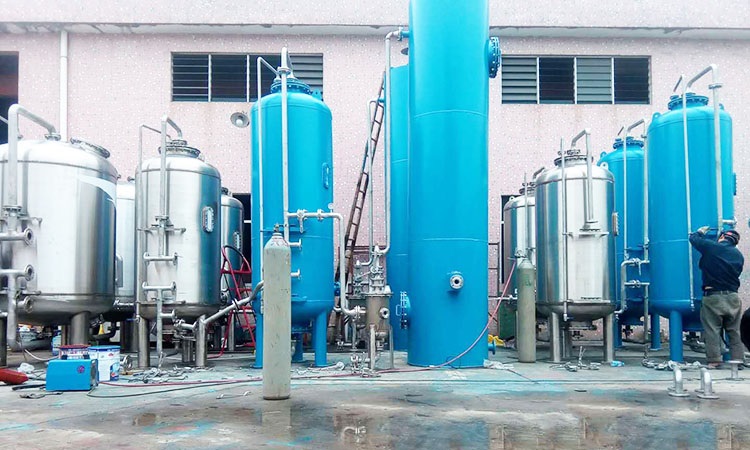
Wechat/Whatsapp:
+8613798883773

Wechat/Whatsapp:
+8613798883773
HYWATER Water softener


Tips about Water softening equipment In daily life, we often see that scale will form on the inner wall of the kettle after a long time, because the usual domestic water contains inorganic salts, such as calcium and magnesium salts. These salts cannot be found by the naked eye in water at room temperature. Once they are heated and boiled, a lot of calcium and magnesium salts will be precipitated as carbonates, and they will form scales close to the pot wall. We usually express the content of calcium and magnesium ions in water with the index "hardness". 1 degree of hardness is equivalent to 10 mg of calcium oxide per liter of water. The water below 8 degrees is called soft water, the water above 17 degrees is called hard water, and the water between 8 and 17 degrees is called moderately hard water. Rain, snow, rivers, rivers, and lakes are all soft water, while spring water, deep well water, and sea water are all hard water. Raw water refers to untreated water. In a broad sense, the water before entering the water treatment process is also called the raw water of the water treatment. Softened water refers to water whose hardness (mainly calcium and magnesium ions in water) is removed or reduced to a certain extent. In the process of softening water, only the hardness decreases, but the total salt content remains unchanged. The calcium and magnesium ions in the raw water are replaced by strong acid cation resin, and the boiler inlet water filtered by the water softening equipment becomes the softened purified water for boilers with extremely low hardness. Ion exchange method 1) Method: Using a specific cation exchange resin, the calcium and magnesium ions in the water are replaced with sodium ions. Due to the high solubility of sodium salts, the formation of scale with the increase of temperature is avoided. 2) Features and effects: The effect is stable and accurate, and the process is mature. The hardness can be reduced to 0. 3) Application scope: in catering, food, chemical, pharmaceutical and other fields, air conditioning, industrial circulating water and other applications. The most commonly used standard method. Membrane method (1) Method: It needs to be used with scale inhibitor. Both nanofiltration membrane (NF) and reverse osmosis membrane (RO) can intercept calcium and magnesium ions in water, thereby fundamentally reducing the hardness of water. The hardness can only be reduced to a certain range. (2) Features and effects: The effect is obvious and stable, and the treated water has a wide range of applications. There are high requirements for the water inlet pressure, and the equipment investment and operating costs are high. (3) Application scope: generally be used for pure water equipment sstem Water softening equipment work flow There are five processes: work (sometimes called water production, the same below), back washing, salt absorption (regeneration), slow flushing (replacement), and fast flushing. All the processes of different softening water equipment are very close, but due to the difference of the actual process or the need for control, there may be some additional processes. Any softened water equipment based on sodium ion exchange is developed on the basis of these five processes (among them, the fully automatic softened water equipment will increase the brine re-injection process) 1) Water softening equipment can help save fuel to improve thermal efficiency When the boiler is scaled, the boiler with a working pressure of 1.4MPa will have a scale of 1 mm, which will waste 8% of the fuel. When there is scale on the evaporation surface of the boiler, the heat from the fire side cannot be quickly transferred to the water side, which will reduce the output of the boiler. If the boiler is fouled due to improper water treatment, the evaporation capacity of the boiler is reduced by one third, and the automatic operation line cannot be started due to insufficient gas supply. 2) Water softening equipment can help reduce boiler maintenance and the risk of safety After the boiler plate or pipeline is covered with scale, it is very difficult to remove, especially due to the leakage, crack, breakage, deformation, corrosion and other diseases of the boiler caused by the scale. It not only damages the boiler, but also consumes a lot of manpower and material resources for maintenance, which not only shortens the running time, but also increases the maintenance cost. Accidents caused by scale in boilers account for more than 20% of the total boiler accidents, which not only cause equipment losses, but also threaten personal safety. The infrastructure and operating costs of water treatment account for a quarter of the savings. More inquiries related to Water softening equipment please contact: Mob& Wechat& WhatsApp: (+86)13544774483 Email: sales010@water-sy.com We will provide high-quality, all-round comprehensive professional services for project consulting, system design, manufacturing, installation and commissioning, personnel training, etc
